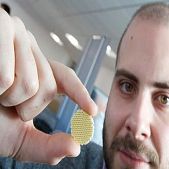
Greek researcher discovers new approach that helps with bone regeneration
Researchers at Nottingham Trent University, among them a Greek researcher, have recently achieved a major step forward in improving the strength of 3D printed bone implants, which could help cancer patients or accident victims who have suffered significant bone loss recover faster than ever. The novel 3D printing process involves manipulating and freezing the growth crystals within a 3D printed material, which reduces the fabrication time of 3D printed bone implants while improving their overall toughness.
Manolis Papastavrou is a researcher of the Design for Health and Wellbeing Research Group in the School of Architecture, Design and the Built Environment.
3D printed synthetic bone implants are already being used to treat patients and help them recover from bone loss. The scaffolds essentially act as tailor-made, temporary ‘bridges’, allowing for the regeneration of the patient’s natural tissue. Because the 3D printed bones are made in part from the same minerals found in natural bone material, they retain a similar level of porosity, allowing the natural bone to grow throughout. Once their job is done, the synthetic bone structures dissolve harmlessly into the patient’s body.
The achievement of the Nottingham Trent researchers comes down to their novel combination of 3D printing and freezing the bone scaffolds’ microstructures. “This research demonstrates how 3D printing in combination with freezing can reduce significantly the fabrication time and cost of such medical devices,” said Manolis Papastavrou, a PhD candidate and member of the University’s Design for Health and Wellbeing Research Group.
3D printing technology in allowed for significant advances in these synthetic bone implants. Using patient-specific imaging data, doctors can 3D print bone implants to the exact measurements and specifications required of each individual. In the past, doctors in China created a 3D printed vertebra for a 12-year-old boy, as well as a 3D printed titanium sternum implant. 3D printing technology has also allowed researchers to use advanced, biocompatible 3D printing materials, including K2M’s Lamellar Titanium Technology, or extrudable calcium phosphate composites.
“The secret behind the toughness of many biological materials is the way their components are arranged from the molecular all the way up to a macro level. Using this design strategy could help engineer bone scaffolds, whose porosity does not compromise their strength.” Papastavrou added that in the long term, this discovery could contribute to replacing the use of metal in orthopaedic implants altogether, meaning implants could be made entirely from biocompatible materials that can be broken down by the body.
Despite all of these successful cases however, finding a way to improve the strenght of 3D printed bones while retaining the structures’ porosity still requires work. Today’s research news suggests that crystals grown in sub-zero temperatures might provide a viable solution.










ΕΦΗ ΣΤΕΦΑΝΑΚΗ
-11/02/2016 1:04 pm
ΣΥΓΧΑΡΗΤΗΡΙΑ!!!!!!!!!!! ΚΑΙ ΕΧΩ ΟΣΤΕΟΠΟΡΩΣΗ
CHRIS.VAVOULOGIANNIS
-17/02/2016 6:18 pm
ΕΥΓΕ!!!